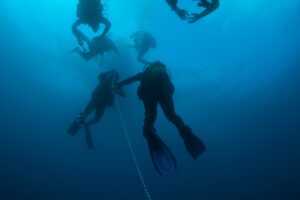What is a Pressure Gauge?
A pressure gauge is an essential instrument in scuba diving, designed to measure and display the pressure of the air supply within a diver’s tank. This device is crucial for ensuring that divers are aware of their remaining air, thereby allowing them to manage their breathing and plan their ascent to the surface safely. Without a reliable pressure gauge, a diver risks running out of air underwater, which could lead to potentially life-threatening situations. Thus, understanding the function and importance of pressure gauges is fundamental for anyone involved in scuba diving.
Historical Development
The development of pressure gauges dates back to the early days of diving when divers used rudimentary methods to estimate their remaining air supply. The earliest attempts at pressure measurement were quite primitive, relying on basic indicators that provided limited information. As diving technology advanced, so did the tools used to ensure diver safety.
In the mid-20th century, the first submersible pressure gauges (SPGs) were introduced, revolutionizing how divers monitored their air supply. These early gauges were analog devices with a simple needle and dial system that displayed the pressure in the tank. The introduction of SPGs marked a significant milestone, as it provided divers with a reliable and straightforward way to monitor their air consumption in real-time.
Over the years, the design and functionality of pressure gauges have evolved considerably. The transition from purely mechanical analog gauges to digital ones began in the late 20th century, driven by advances in electronics and materials science. Digital pressure gauges offered greater accuracy and additional features, such as integrated alarms and more precise readings. Today, the development continues with the integration of pressure gauges into sophisticated dive computers, providing divers with comprehensive data about their dive in a compact and efficient format.
Types of Pressure Gauges
Pressure gauges used in scuba diving can be broadly categorized into three types: submersible pressure gauges (SPGs), digital pressure gauges, and integrated dive computers.
Submersible Pressure Gauges (SPGs) are the most traditional type of pressure gauge. These devices consist of a mechanical dial and needle that indicates the pressure in the tank. SPGs are valued for their simplicity, reliability, and durability. They are often encased in robust, water-resistant housings and are designed to withstand the harsh conditions of underwater environments. SPGs typically display the pressure in both bar and psi, allowing divers to choose their preferred unit of measurement.
Digital Pressure Gauges represent a more modern approach to monitoring tank pressure. These devices use electronic sensors to measure the pressure and display the reading on a digital screen. Digital gauges often come with additional features, such as backlighting for better visibility in low-light conditions, alarms that alert the diver when the air supply is low, and even logging capabilities to record pressure data over time. The accuracy and ease of reading digital gauges make them a popular choice among divers who prefer a more technological approach to their equipment.
Integrated Dive Computers take the functionality of digital pressure gauges a step further by incorporating them into comprehensive diving instruments. These devices not only measure and display tank pressure but also provide a wealth of other information, such as depth, time, temperature, and decompression status. Integrated dive computers are often wrist-mounted or console-mounted and offer a high level of convenience by consolidating multiple pieces of information into a single device. This integration allows divers to have all the critical data they need at a glance, enhancing both safety and diving experience.
Physical and Operational Principles
The operation of pressure gauges is rooted in basic physical principles, particularly Boyle’s Law, which states that the pressure of a gas is inversely proportional to its volume at constant temperature. This principle is crucial in understanding how pressure gauges work, as the pressure inside a scuba tank decreases as the air is consumed, and this decrease is measured by the gauge.
A typical pressure gauge consists of several key components, including the Bourdon tube, which is a curved, flexible tube that straightens as the internal pressure increases. This movement is mechanically linked to a needle that moves across a dial to indicate the pressure. The construction materials for these components are selected for their durability and resistance to corrosion, ensuring reliable performance even in saltwater environments.
Digital pressure gauges operate on similar principles but use electronic sensors to measure the pressure. These sensors, often piezoelectric or strain-gauge types, detect the pressure changes and convert them into electrical signals. These signals are then processed by the device’s microcontroller to provide a digital readout. The precision and accuracy of these sensors make digital gauges highly reliable, with less mechanical wear and tear compared to their analog counterparts.
The way readings are obtained and displayed varies slightly between analog and digital gauges. Analog gauges provide a continuous reading via the needle and dial system, which some divers prefer for its simplicity and instant readability. Digital gauges, on the other hand, display numerical values that can be easier to interpret quickly, especially for divers who are accustomed to digital interfaces. Both types of gauges are designed to be easy to read underwater, with features like luminescent dials or backlit screens to enhance visibility.
Importance in Scuba Diving Safety
The role of the pressure gauge in scuba diving cannot be overstated. It is a critical safety device that helps divers monitor their air supply and manage their dive profiles effectively. Knowing the pressure in the tank allows divers to plan their dive and ascent to ensure they have enough air to return to the surface safely.
In practical terms, the pressure gauge helps divers avoid potentially dangerous situations such as running out of air at depth. For example, a diver at 20 meters (65.6 feet) who suddenly finds themselves low on air needs to make a controlled ascent to avoid decompression sickness. The pressure gauge provides the information needed to make such decisions in real-time. Furthermore, regular monitoring of the pressure gauge during a dive allows divers to adjust their air consumption and make informed decisions about extending or shortening their dive.
The consequences of equipment failure, including pressure gauge malfunction, can be severe. Regular maintenance and checks are essential to ensure the reliability of the gauge. Divers are trained to inspect their equipment before each dive, including checking the pressure gauge for any signs of damage or malfunction. This preventive approach helps mitigate the risks associated with equipment failure and enhances overall diving safety.
Maintenance and Troubleshooting
Regular maintenance of pressure gauges is crucial for their accurate and reliable performance. Divers should inspect their gauges before each dive, looking for any visible signs of damage, such as cracks in the glass, corrosion, or leaks in the connections. Keeping the gauge clean and free from salt deposits and other debris is essential for its longevity. After diving, rinsing the gauge with fresh water and allowing it to dry completely can help prevent corrosion and other damage.
Common issues that divers might encounter with pressure gauges include sticking needles, inaccurate readings, or complete failure of the gauge to register pressure. Troubleshooting these issues involves a systematic approach to identify the cause. For example, a sticking needle might be caused by debris or corrosion inside the gauge, which can often be resolved by cleaning. Inaccurate readings may indicate a need for recalibration, which should be performed by a qualified technician. In cases where the gauge fails to register pressure at all, checking the connections and the integrity of the Bourdon tube or sensor can help diagnose the problem.
To ensure the longevity and reliability of pressure gauges, divers should follow the manufacturer’s recommendations for maintenance and servicing. This often includes periodic professional servicing, especially for digital gauges and integrated dive computers, which may require software updates or calibration. Proper storage of the gauge when not in use, such as keeping it in a cool, dry place away from direct sunlight and extreme temperatures, also helps maintain its performance.
Advancements and Future Trends
Recent advancements in pressure gauge technology have focused on improving accuracy, durability, and user interface. Materials science has contributed to the development of more robust and corrosion-resistant materials, extending the lifespan of pressure gauges and reducing maintenance needs. In addition, advances in electronics have led to more precise sensors and better integration with other diving equipment.
Future trends in pressure gauge technology are likely to see further integration with dive computers and other digital devices. The use of wireless technology to transmit pressure data from the tank to a wrist-mounted dive computer or even a heads-up display in the diver’s mask is an area of active development. This kind of integration can provide divers with real-time data without the need for manual checking, enhancing safety and convenience.
Another promising area of development is the use of artificial intelligence (AI) to analyze pressure data and provide predictive insights. AI could help divers better understand their air consumption patterns and optimize their dive plans accordingly. For example, an AI-powered system could alert divers to potential issues based on their historical data, such as unusual air consumption rates that might indicate a leak or other problem.
Key Takeaways
Pressure gauges are indispensable tools for scuba divers, providing critical information about air supply and enhancing safety underwater. From their historical development to modern advancements, these devices have evolved significantly, incorporating advanced technology to offer better accuracy and reliability. Proper maintenance and understanding of how pressure gauges work are essential for safe diving practices, making them a fundamental piece of equipment for every diver.

















